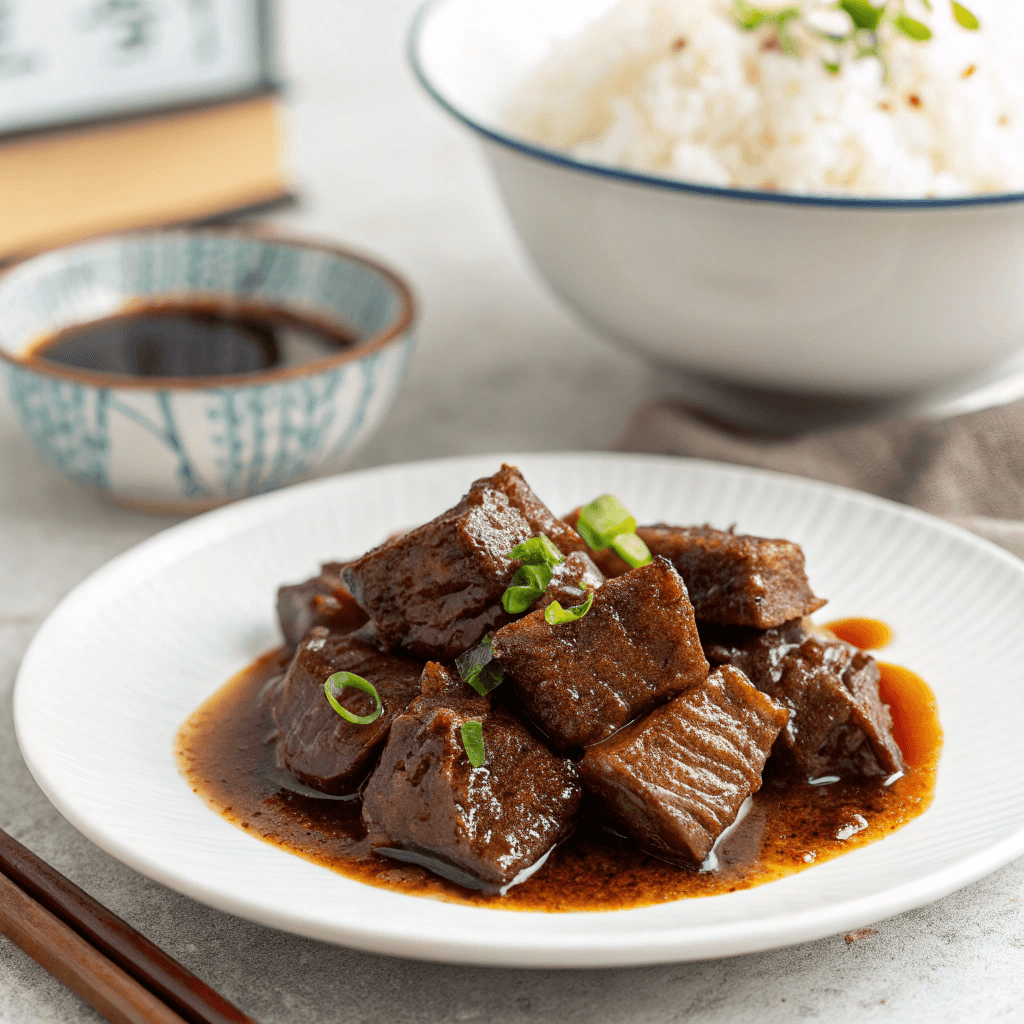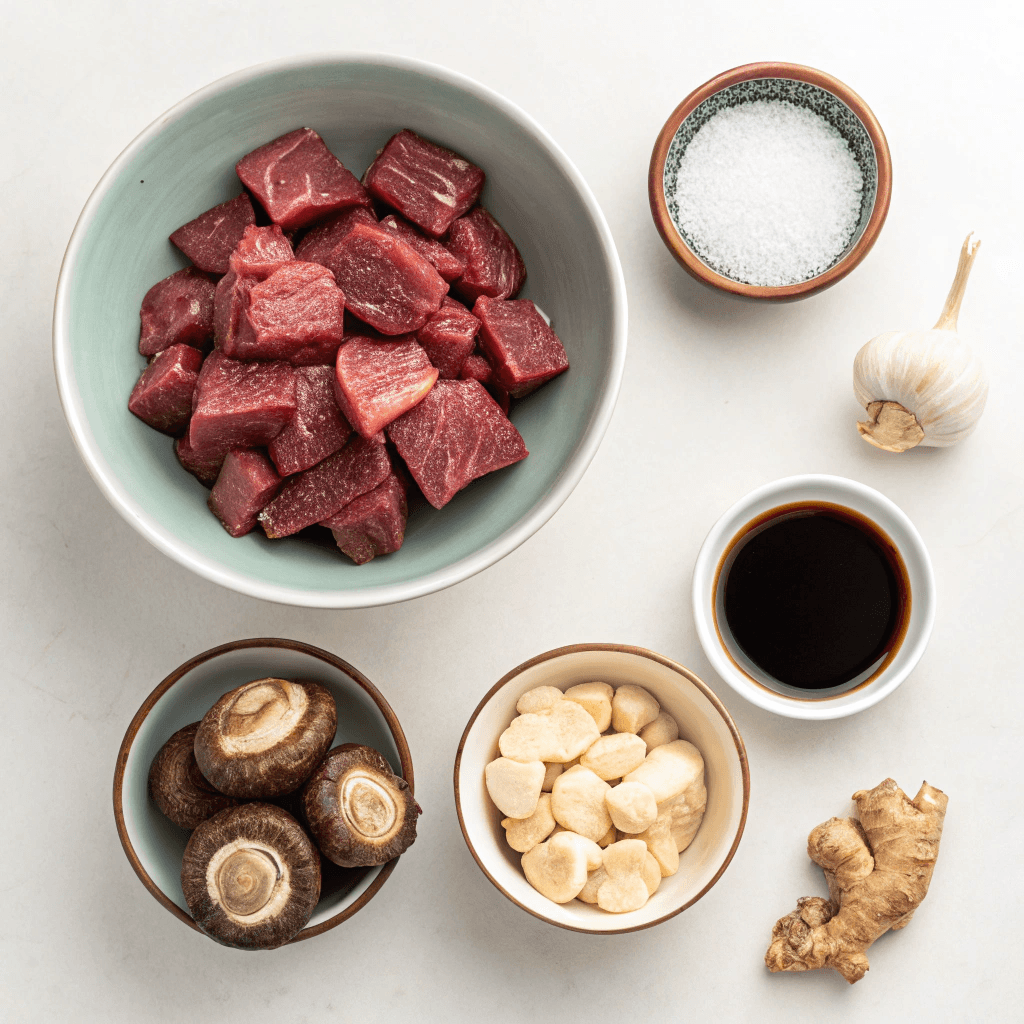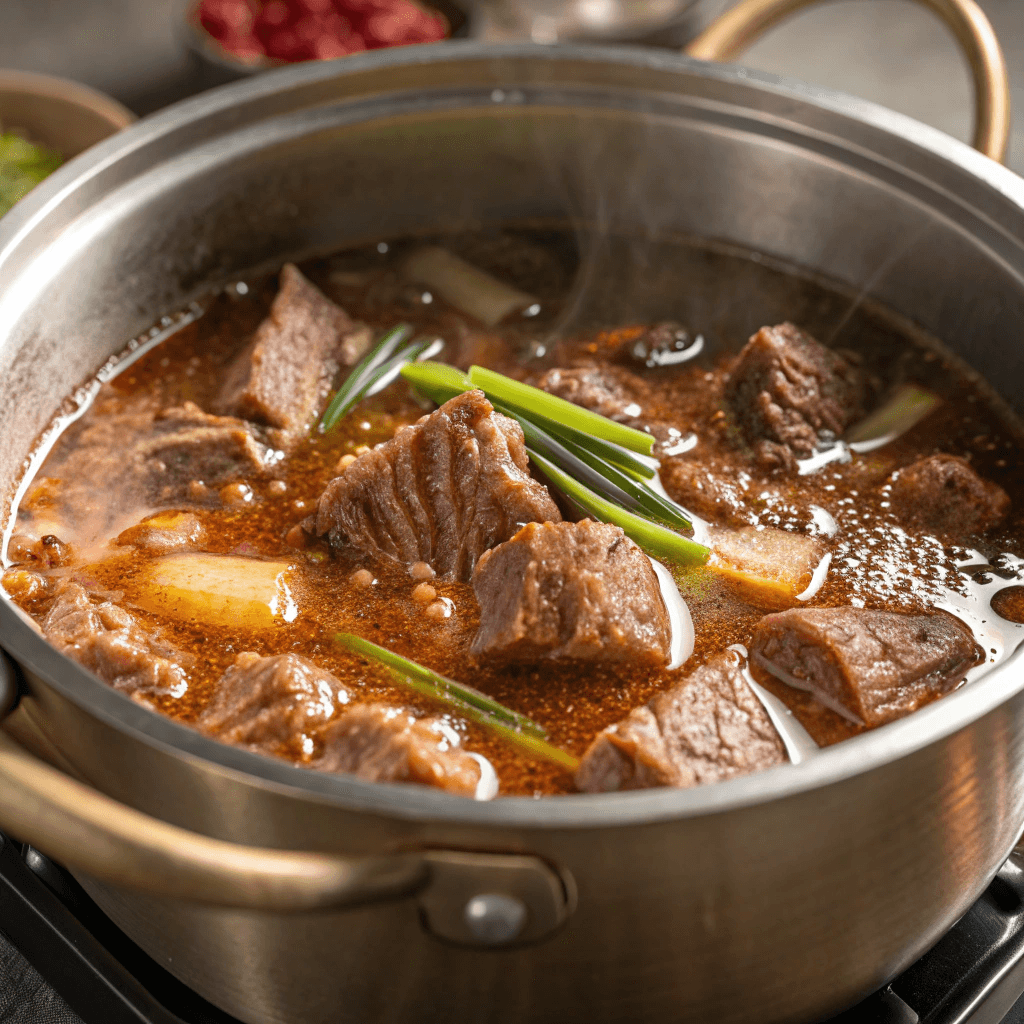Jangjorim : Korean Braised Beef
Jangjorim, a beloved Korean side dish, features tender meat simmered in a savory-sweet soy sauce broth. This guide covers its history, variations, and recipe for home cooks.
Jangjorim, a classic Korean braised dish, offers a delightful combination of tender meat and a rich, savory-sweet flavor. It’s a versatile banchan (side dish) that complements any meal, adding a touch of tradition to your table. In this comprehensive guide, we will dive deep into the world of Jangjorim, exploring its fascinating history, essential ingredients, step-by-step cooking process, and much more. You’ll discover how to make this cherished dish at home, unlocking a new level of culinary appreciation. Moreover, you’ll gain insights into its cultural significance and how it has evolved over time. Whether you’re a seasoned cook or a kitchen novice, this article provides everything you need to master the art of making Jangjorim. So, let’s begin our journey into the heart of Korean cuisine.
Table of Contents
The Story Behind Korean Braised Beef: A Look at Jangjorim’s History
Ancient Roots of Braised Dishes
The practice of braising meats, such as for Korean braised beef, has its roots deep in history, often linked to methods of food preservation. For example, ancient cultures used braising to tenderize tough cuts of meat and extend their shelf life. Therefore, in Korea, braising became an essential cooking technique long before modern refrigeration. This allowed families to enjoy flavorful dishes, especially during long journeys or harsh seasons.
Royal Connections of Jangjorim
Furthermore, while Jangjorim’s humble origins suggest everyday family meals, this dish also might have touched royal tables at some point. Traditional recipes often found their way into the royal kitchens, adapted for the tastes of the court. However, specific historical records linking Jangjorim directly to royal cuisine are limited. Nevertheless, its careful preparation and exquisite balance of flavors suggest it was a dish of importance.
Evolution Over Time
Moreover, the recipe for Jangjorim has undoubtedly evolved over the centuries, adapting to changing tastes and ingredient availability. For instance, modern variations may incorporate new spices or ingredients. In addition, the fundamental concept of slowly simmering meat in a flavorful soy-based broth remains. Hence, this enduring recipe keeps its place in Korean cuisine. It continues to satisfy palates across generations.
Jangjorim as a Korean Staple Side Dish
As a staple “banchan” (side dish) in Korean cuisine, Jangjorim plays an important role in meals. The dish is usually part of the multiple side dishes that accompany a main course. Its long shelf life makes it perfect for meal prepping. This makes it practical and useful for a variety of occasions. For example, you’ll frequently find it in packed lunches or served at family gatherings.
Cultural Symbolism and Significance
Also, Jangjorim has grown into more than just a meal; it represents family and home-cooked tradition. Preparing and sharing it is often a gesture of love and care. Moreover, it’s a reminder of the resourcefulness of Korean cooking techniques, transforming simple ingredients into something truly delicious. Therefore, this dish goes beyond just sustenance; it is part of Korea’s rich culinary heritage.
Jangjorim in Korean-American Communities
Today, Jangjorim continues to thrive in Korean-American communities, therefore preserving its cultural value. It connects generations through a shared culinary experience. Also, it represents the fusion of Korean culinary traditions with American life. Therefore, this results in some adaptations while retaining its essence.

Understanding the Key Ingredients for Jangjorim

Selecting the Right Protein for Braised Meat: Beef
Firstly, for a successful Jangjorim, selecting the proper cut of meat is essential. For beef, lean, yet flavorful cuts are preferred, such as chuck or brisket. These cuts have connective tissue, which breaks down during slow cooking, making the meat incredibly tender. Secondly, cuts like sirloin or round steak can also be used. However, they might not have the same level of tenderness and flavor. Therefore, be sure to choose high-quality meat for best results. The meat should also be trimmed of excess fat to avoid a greasy final dish.
The Importance of Soy Sauce for Jangjorim
The base of the braising liquid is soy sauce, therefore its quality significantly impacts the flavor of your Jangjorim. Korean soy sauce is typically used and has a slightly sweeter and less salty profile than other varieties. Moreover, you can use either regular or dark soy sauce. However, the dark soy sauce adds a richer color. The amount and type of soy sauce you use directly affect the dish’s saltiness, color, and overall flavor. Therefore, make sure to adjust the quantity according to your taste preference.
Enhancing Flavor: Garlic, Ginger, and Sugar
In addition to the base of soy sauce, garlic and ginger are crucial for adding depth of flavor to your Korean Braised Beef. Garlic provides a pungent and savory note, while ginger adds a warm, aromatic touch. Furthermore, sugar is essential for balancing the saltiness of the soy sauce and contributing to the glaze. For example, you can use white sugar, brown sugar, honey, or even corn syrup. However, each one can provide subtle flavor variations. Therefore, experiment to find the best balance for your palate.
Optional Ingredients: Adding Layers of Flavor
Moreover, while the main ingredients provide the base flavor, several optional additions can elevate your Jangjorim. Dried shiitake mushrooms, for instance, add a deep umami flavor. Also, quail eggs give the dish a beautiful visual touch as well as a pleasant textural variety. Furthermore, for a more traditional flavor, some cooks may add dried anchovies or kelp (dashima) to the braising liquid. This creates a complex broth. In addition, some may add a touch of chili for a bit of spice. Therefore, adding extra ingredients can tailor the dish to your preference.
Step-by-Step Guide to Making Korean Braised Meat
Preparing the Meat
To begin with, start by trimming any excess fat from the beef or pork, unless using the pork belly. Cut the meat into large, manageable chunks, approximately 2 to 3 inches in size. This size ensures the meat cooks evenly and tenderizes properly. Searing the meat in a hot pan with a touch of oil can help develop additional flavor. However, it is not essential, and you can skip it for a simpler cooking process. Therefore, prepare your meat pieces for the braising.
Crafting the Braising Liquid
Next, combine soy sauce, water, sugar, minced garlic, and grated ginger in a pot. The ratio of soy sauce to water is usually around 1:2 or 1:3, but it can be adjusted according to your taste preference. You should aim for a balanced sweet and salty flavor. If you choose to use dried anchovies or kelp, add them now to create an enriched broth. Stir well to combine the ingredients, and place it over medium heat. Therefore, preparing the braising liquid carefully will allow the flavors to meld together.
Simmering to Perfection
Add the meat pieces to the braising liquid once it starts simmering. Ensure the liquid is enough to cover the meat. If needed, you can add more water or soy sauce. Bring the liquid to a gentle simmer, then lower the heat, cover the pot, and let it braise slowly. This low and slow simmering process will create unbelievably tender meat. Skim off any impurities that rise to the surface while cooking to keep the broth clean. Therefore, the key is to be patient and let it simmer for at least 1.5 to 2 hours.
Incorporating Optional Ingredients
If you choose to add dried shiitake mushrooms, soak them in warm water first to rehydrate them. Add them into the pot about 30-45 minutes before the braising is finished. This also applies to peeled boiled quail eggs. This step is optional and depends on your preferences. Therefore, adding extras during the final stage allows their flavors to blend without overcooking.
Checking for Tenderness and Adjusting Flavors
To check for tenderness, try shredding a piece of meat with a fork. It should shred easily. If the meat is not tender enough, continue braising for another 30 minutes. Additionally, check the liquid level and reduce the sauce if it is too watery. This helps to concentrate the flavors and create a luscious, glossy glaze. Lastly, taste the braising liquid and adjust the seasoning if needed. You might add a touch more sugar for sweetness or soy sauce for saltiness. Therefore, adjust it until you reach your desired taste.
Allowing to Cool Completely
Once the meat is tender and the sauce has reached the desired consistency, remove the pot from heat. Allow the Jangjorim to cool completely in the braising liquid before serving. This cooling period allows the flavors to fully develop and meld together. Therefore, this is a critical step in achieving the best taste of your Jangjorim. Furthermore, keeping the meat in the broth during the cooling will make it even more flavorful.

Variations and Adaptations of Korean Braised Meat
Beef vs. Pork Jangjorim
The main difference between beef and pork Jangjorim lies in the flavor profile and richness. Beef Jangjorim typically has a cleaner, leaner taste, while pork Jangjorim tends to be richer and more succulent due to the higher fat content. The cooking process, however, remains essentially the same. Therefore, the choice between beef or pork depends solely on your taste preferences.
Regional Adaptations in Korea
While the basic recipe for Jangjorim is consistent across Korea, some subtle regional variations might exist. For example, different types of soy sauce or locally available vegetables might be incorporated, altering the final flavor slightly. Also, some regions may prefer a sweeter or spicier profile compared to others. Therefore, variations in different regions demonstrate the diversity of Korean culinary traditions.
Modern Twists on Jangjorim
Moreover, contemporary adaptations of Jangjorim include using additional ingredients for flavor enhancement. For example, adding gochujang (Korean chili paste) for a spicy kick is a common twist. Also, some cooks might use different kinds of mushrooms or include a variety of vegetables. Furthermore, you can use alternative sweeteners such as maple syrup or honey, therefore adding new flavor notes. Consequently, exploring these modern variations can be a fun way to experiment and create your unique version.
Serving and Pairing Jangjorim
Traditional Ways to Serve Jangjorim
Usually, Jangjorim is served as a side dish, or “banchan,” as part of a traditional Korean meal. It is typically served at room temperature or slightly chilled, although it can also be served warm. Usually, the meat is sliced or shredded and then placed alongside the braising sauce. This makes a delicious and versatile side dish.

Complementary Dishes for Jangjorim
Jangjorim pairs well with other Korean dishes, such as rice, and other vegetable side dishes. Its salty and savory-sweet flavor helps to balance the richness of other flavors. In addition, it complements various types of Korean mains. Therefore, consider it a key element in a balanced and delicious meal. For a great pairing, serve it alongside a refreshing Kimchi Spinach Salad or a Quick Kimchi Pears dish. Also, check the Kimchi Jar Recipe for another great side dish idea! You can also consider a Kimchi Salad recipe or try it with delicious Barley Kimchi Pancakes.
Serving Suggestions
You can serve it whole, sliced, or shredded. The choice will depend on your personal preference and also the dish you want to pair it with. The braising sauce should always be served alongside, as it’s essential to the overall flavor experience. For example, you can use it to fill kimbap (seaweed rice rolls) or even as a topping on a warm bowl of rice. Therefore, be creative in using this versatile dish.
Storage and Reheating of Jangjorim
Proper Storage Techniques
To store leftover Jangjorim, place it in an airtight container in the refrigerator. The braising liquid helps to preserve the meat. Make sure to store it with the braising liquid to keep it moist and flavorful. Therefore, proper storage is vital for maintaining both freshness and taste.
Shelf Life of Jangjorim
Properly stored Jangjorim can last for several days, or up to one week in the refrigerator. However, it’s best to consume it within 3-5 days for optimal flavor and texture. Therefore, always check for any signs of spoilage.
Reheating Jangjorim
Reheating is straightforward. You can reheat it gently on the stovetop over low heat. You can also use the microwave. However, the stovetop method is better for retaining moisture and flavor. Reheat until it’s warm, making sure not to overcook it and dry the meat. Therefore, you can enjoy your delicious Jangjorim as a wonderful meal, even after storing it.
Common Mistakes to Avoid when Making Jangjorim
Overcooking or Undercooking the Meat
One common mistake is either overcooking or undercooking the meat. Braising it for too long can make the meat mushy and also dry out the sauce. On the other hand, not braising it long enough will result in tough meat. Therefore, paying attention to the simmering time is crucial for proper tenderness.
Unbalanced Sweetness and Saltiness
Another mistake is not achieving the right balance of sweetness and saltiness. It can be easy to add too much or too little sugar or soy sauce. The key is to taste and adjust the seasoning while cooking to achieve a delicious, balanced flavor. Therefore, you need to carefully adjust the seasonings throughout the cooking process.
Forgetting to Skim Impurities
Forgetting to skim off impurities that rise to the surface while cooking can affect the taste and clarity of the sauce. The impurities can add a bitter and murky taste to your Jangjorim. Therefore, it’s important to keep the broth clean. This will result in a more flavorful dish.
Frequently Asked Questions About Korean Braised Meat (Jangjorim)
What does Jangjorim taste like?
Jangjorim has a savory-sweet flavor, with the main notes from the soy sauce and sugar. The meat is incredibly tender and infused with the flavors of garlic and ginger. It may also contain the subtle umami flavors of mushrooms, if used. It balances saltiness with sweetness, making it a flavorful banchan.
How long does Jangjorim last in the fridge?
Jangjorim can last for about 3 to 5 days in the refrigerator when stored in an airtight container. It’s important to keep it in the braising liquid to prevent it from drying out. Also, ensure to check for spoilage signs.
Can I use other types of meat for Jangjorim?
While beef and pork are the most common choices for Jangjorim, you can experiment with other types of meat. However, be sure to select cuts that braise well, such as chicken thighs. The cooking time may vary, depending on the type of meat you use. Also, you may need to adapt the flavor profiles for different types of meat.
Can I make Jangjorim in a slow cooker?
Yes, you can make Jangjorim in a slow cooker. Combine all the ingredients in the slow cooker and cook on low for 6-8 hours, or on high for 3-4 hours, until the meat is tender. The convenience of slow cookers makes them a great alternative to traditional stovetop cooking.
Nutritional content
This is an approximate nutritional breakdown per 100g of Jangjorim. These values can vary depending on the exact ingredients and proportions used.
| Nutritional Information (per 100g) | Amount |
| Calories | 180-220 kcal |
| Protein | 15-20 g |
| Fat | 8-12 g |
| Saturated Fat | 3-5 g |
| Carbohydrates | 5-10 g |
| Sugar | 4-8 g |
| Sodium | 600-800 mg |
Conclusion
In conclusion, Jangjorim is not only a delicious and versatile dish but also a significant part of Korean culinary tradition. This comprehensive guide has walked you through its history, ingredients, cooking process, and ways to enjoy it. Therefore, with the information you’ve gained in this article, you now have all the knowledge you need to create this exceptional Korean braised dish right at home. Now, it is time to put these steps into practice. Start cooking your own Jangjorim and savor the wonderful taste of Korean cuisine! Also, be sure to explore other Korean recipes like the Spicy Korean Tteokbokki for a complete meal. If you’re looking for something to enjoy for breakfast, consider the Spicy Kimchi Breakfast Bowl or try the Kimchi Spicy Frittata! And for a quick meal, you can try a Kimchi Fried Rice, or try Korean fusion dishes like Kimchi BBQ Tacos or the Chicken Kimchi Burrito. You can also explore other noodle dishes like the Bibim Guksu.
we suggest you to try this side dish also :







